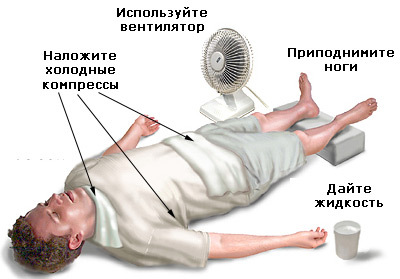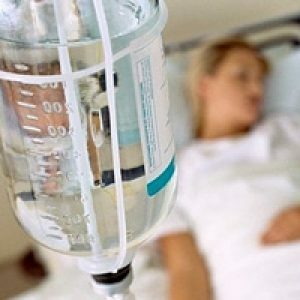Aneurysm of cerebral vessels: symptoms, treatment, aneurysm operations
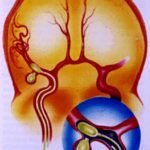
If the walls of one of the arteries of the brain become thinner, its bulging appears, filled with blood, then the doctors will diagnose aneurysm of cerebral vessels .A person with this diagnosis runs the risk of dying at any moment - in the aneurysm site the artery does not have a muscle "layer" and membrane, and this reduces the elasticity and strength of the vessel to zero.Especially high risk of rupture of the thinned vessel wall - there will be a hemorrhage in the brain, and an aneurysm puts pressure on the surrounding brain tissue and blood vessels.
Contents: Why the cerebral aneurysm develops Types of cerebral aneurysm Symptoms of cerebral artery aneurysms Complications of brain aneurysm How to diagnose cerebral aneurysm How to treat an aneurysmWhy develops an aneurysm of the brain vessels
The disease under consideration presents a real danger to lifeMan, so his study takes a lot of time and effort.The following factors were identified, which can provoke the appearance of the swelling of the thinned wall of the cerebral artery.These include:
- The use of substances from the narcotic series, smoking.
- Brain arterial trauma - for example, on the background of a craniocerebral trauma, fracture of the base of the skull and so on.
- Embolism of the arteries.In this case, microscopic fragments of the malignant tumor( if any) or colonies of bacterial / fungal microorganisms are transferred.
- Diagnosed and progressive atherosclerosis of cerebral vessels.
- Collagen type 3 deficiency.This is generally a hereditary factor, therefore in some families an aneurysm of cerebral vessels is diagnosed from genus to genus.
- Hyaline wall of blood vessels.
- Constantly elevated blood pressure, especially in the case of disregard of treatment and recommendations of doctors.
- Human exposure to radioactive radiation, and it does not matter how long this exposure is.
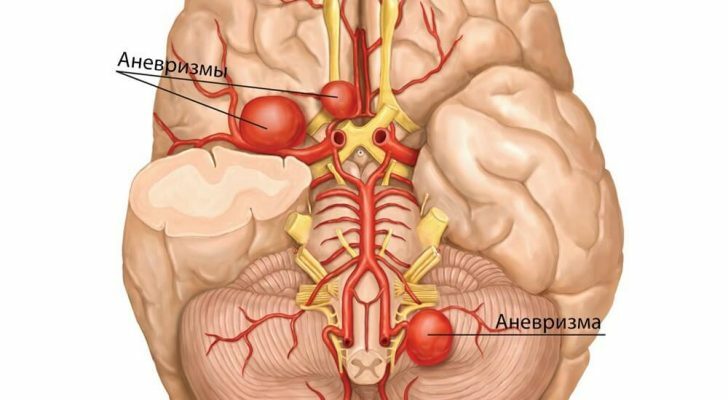
In addition, doctors are well aware of some features of the course of the disease in question:
- most often an aneurysm of the cerebral vessels is diagnosed at the age of 30-60 years;
- statistics show that women are more likely to suffer from the disease than men;
- in recent years, scientists and doctors say a high risk of transmission of pathology by inheritance;
- every year in 27 thousand people with an aneurysm diagnosis there is a gap - this data applies only to the US.
Types of cerebral aneurysms
In medicine, there is a clear classification of bulging of the walls of the artery of the head vessel.First, an aneurysm is classified according to its form:
- lateral - an aneurysm looks like a flat formation on a vessel, characterized by a tumor-like character;
- saclet I - has a rounded shape, connected by a neck to the trunk of the artery;
- spindle-shaped - is formed against the background of the expansion of the vessel and only in a certain area.
Secondly, the classification of the considered disease is also of size:
- small - bulging has a size of up to 11 mm;
- mean - aneurysm grows up to 25 mm;
- large - wall swelling has a diameter of more than 25 mm.
Symptoms of cerebral aneurysms
The most terrible thing is that the aneurysm of the cerebral vessels often passes asymptomatically - the person does not bother, he leads an active lifestyle.With such a disease you can live a lifetime without knowing the diagnosis.But most often an aneurysm manifests itself as severe symptoms with its growth, or with a rupture of the vessel.
If the aneurysm has reached large volumes, then it begins to exert pressure on surrounding tissues and blood vessels - a person will be disturbed by severe symptoms:
- in some parts of the face there is numbness;
- may develop paralysis of the facial muscles( as a rule, it is of a one-sided nature);
- vision worsens;
- it is possible to expand one pupil - in medicine this condition is classified as mydriasis;
- hearing impairment;Fallout of fields of vision.
- .The rupture of the aneurysm, cerebral hemorrhage will be accompanied by the following symptoms:
- acute headache, some patients literally screaming from it;
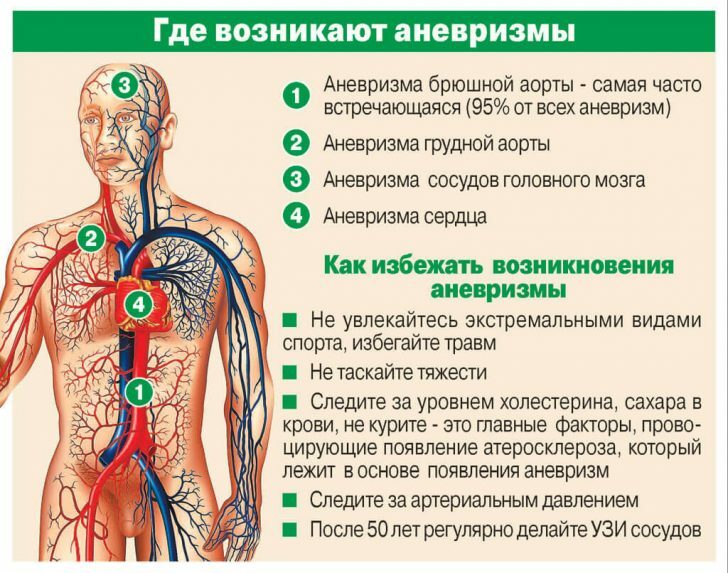
- infringe on defecation and urination - they can occur spontaneously;
- the patient loses consciousness( this symptom does not always have a place to be);
- the speech function is broken - a person starts talking too slowly, some sounds can not be spoken;
- lost coordination;
- is rapidly developing nausea, which always ends with vomiting;
- impaired function of swallowing;
- becomes too high sensitivity to extraneous noise and light;
- limbs( upper and lower on one side) are paralyzed;
- the patient becomes restless, anxious;
- may cause seizures.
Complications of cerebral aneurysm

The most dangerous complication of the disease under consideration is the rupture of the vessel.And, to predict this development of the disease is not given to anyone - the patient in general can live for decades with the swelling of the thinned wall of the cerebral vessel and learn about his disease only when the vessel is ruptured.
According to statistics, an aneurysmal rupture in 50% of cases leads to death, 25% of patients become disabled, and only 25% of patients after a hemorrhage into the brain return to a full life without restrictions.
The consequences of cerebral aneurysms include( apart from rupture):
- hydrocephalus of the brain;
- coma;
- damage to the brain is irreversible;
- stroke of hemorrhagic type;
- vasospasm.
Hemorrhage with aneurysm rupture can occur in different parts of the brain, but in any case it will be accompanied by cerebral edema, increased intracranial pressure, plugging of liquor pathways, displacement of brain structures.Blood that is in the brain tissues, eventually begins to disintegrate( this is a natural process), which causes the development of the inflammatory process in the brain tissues.Against this background, cell necrosis starts, and the result will be the loss of the functions of those parts of the brain where these inflamed and necrotic tissue sites are located.
If the hemorrhage has passed through the subarachnoid type, it can lead to cerebral angiospasm, which always ends with ischemia of the brain tissue.
How the cerebral aneurysm
is diagnosed. It is quite difficult to diagnose an aneurysm formed, therefore the main methods of this exercise are used in the already completed gap of .As part of the diagnostics, the following procedures are provided:
- computed tomography is a noninvasive type of research that allows the location of the rupture of the vessel, and assess the amount of damage;
- Investigation of cerebrospinal fluid - the patient undergoes spinal puncture and cerebrospinal fluid intake and determines to which area of the brain a hemorrhage occurred( for example, with subarachnoid hemorrhage in the cerebrospinal fluid there will be blood);
- angiography - X-ray examination with contrast substances, which allows to see / evaluate the condition of all cerebral vessels;
- magnetic resonance imaging - with its help you can get the most accurate results about the size and location of the rupture of the cerebral vessel.
Note: if there are no symptoms of growing aneurysm of the cerebral vessels or its rupture, then it is not advisable to carry out frequent diagnostic measures.The only exception is the category of people who have a risk of developing an aneurysm against a hereditary factor.
How to treat an aneurysm
If an aneurysm is not severed yet, then only the attending physician can determine the feasibility of treating the disease.Treatment of the disease in question can only be carried out through surgical intervention, but this also entails certain risks.Therefore, it is not only the attending physician, but also the specialists of other medical branches, who should make the decision about conducting the operation concerning the diagnosed aneurysm of the cerebral vessels.Before surgery, the location of the aneurysm, its size, the general health of the patient and many other factors are taken into account.
Note: if the aneurysm is less than 10 mm in size, then doctors do not recommend surgery - the risk of aneurysm rupture is extremely small.
If the decision to conduct an operative intervention has already been taken, the surgeon's work can be performed in two ways:
- Endovascular operation .A catheter is inserted into the femoral artery, at the end of which there is a balloon or capsule.Under constant monitoring with the help of computed tomography, the catheter is advanced to a vessel with an existing aneurysm.Just in the place of an aneurysm, a balloon or capsule is left - it helps to stop the circulation in the damaged area of the vessels.Moreover, there is no influence on the blood supply to the brain - this process takes place in full.
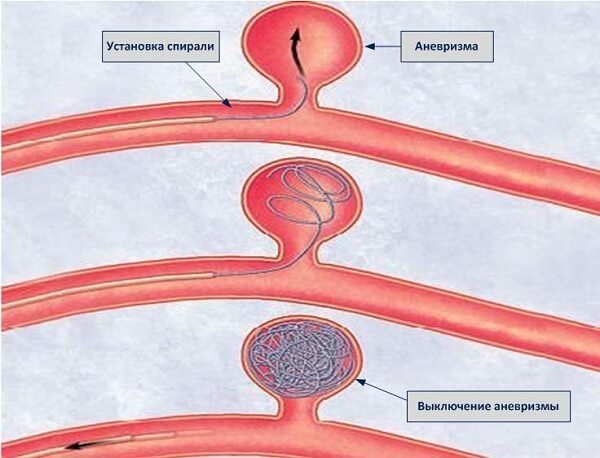
Note: is the endovascular surgery for cerebral aneurysms considered preferable - they are less traumatic and more effective.
- Aneurysm clipping .Such surgical intervention is necessary only through trepanation of the skull - the most complicated neurosurgical operation, the purpose of which is to exclude the damaged portion of the vessel from the total blood flow.In the work the surgeon uses a special microscope and a specific technique( microsurgical).
 After conducting an operative intervention for an aneurysm, the patient will have to undergo a long rehabilitation period.If an aneurysm ruptured already, but the person remained alive, then he will also need a complex rehabilitation.Usually such patients are recommended massage courses, visits to specialized sanatoriums, exercise therapy, electrostimulation, speech gymnastics and other methods of restoring the active vital activity of the body.
After conducting an operative intervention for an aneurysm, the patient will have to undergo a long rehabilitation period.If an aneurysm ruptured already, but the person remained alive, then he will also need a complex rehabilitation.Usually such patients are recommended massage courses, visits to specialized sanatoriums, exercise therapy, electrostimulation, speech gymnastics and other methods of restoring the active vital activity of the body.
Tsygankova Yana Aleksandrovna, medical reviewer, therapist of the highest qualification category


